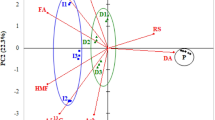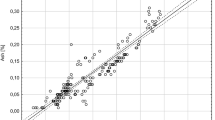Abstract
Sidr honey represents one of the most expensive monofloral honeys worldwide. The quality control of such honey types usually depends on pollen analysis or comparison of physicochemical characters. In the presented work, 38 different honey samples of which 13 represented genuine Sidr (Ziziphus spina-christy) honey samples were collected from various areas of Yemen. All samples were characterized by physicochemical parameters including moisture content, pH, electrical conductivity, and free acidity. The physicochemical data was subjected to multivariate data analysis including principal component analysis (PCA) and hierarchical cluster analysis (HCA). The development of partial least square discriminant analysis (PLS-DA) model on validation gave 100 % correct classification of the test set samples. All tested honey samples were within the level permitted by the international standards for honey quality. The application of the discriminant technique PLS-DA presented excellent potential for discriminating the botanical origin of Yemeni Sidr honey from other non-Sidr samples and may serve as a discriminant model to be applied to other honey types worldwide.





Similar content being viewed by others
References
Al-Khalifa AS, Al-Arify IA (1999) Physicochemical characteristics and pollen spectrum of some Saudi honeys. Food Chem 67:21–25
Alqarni AS, Owayss A, Mahmoud A (2016) Physicochemical characteristics, total phenols and pigments of national and international honeys in Saudi Arabia. Arab J Chem 9(1):114–120
AL-Zoreky N, Alza’aemy A, Alhumiari A (2001) Quality spectrum of Yemeni honey. Damascus U J Agric Sci 17(2):110–117
Arvanitoyannis I, Chalhoub C, Gotsiou P, Lydakis-Simantiris N, Kefalas P (2005) Novel quality control methods in conjunction with chemometrics (multivariate analysis) for detecting honey authenticity. Crit Rev Food Sci 45(3):193–203
Bogdanov S (2002) Harmonised methods of the International Honey Commission. http://www.usamvcluj.ro/Diagnoza/IHCmethods_e.pdf Accessed 26 Feb 2016
Bogdanov S, Rouff K, Oddo LP (2004) Physico-chemical methods for characterization of unifloral honeys: a review. Apidologie 35:S4–S17
Codex Alimentarius (2001). Revised Codex Standard for Honey. In: Codex Standard 12–1981. Rev 1 (1987), Rev 2 (2001). FAO, Rome
Corbella E, Cozzolino D (2005) The use of visible and near infrared spectroscopy to classify the floral origin of honey samples produced in Uruguay. J Near Infrared Spectrosc 13(2):63–68
European Economic Community (2002) EEC council directive of 20 December 2001 relating to honey. Off J Eur Communities 110:47–50
FAO (2001). Non-wood forest products in the near east: a regional and national overview, country report, Yemen http://www.fao.org/DOCREP/003/Y1797E/Y1797E00HTM. Accessed 26 Feb 2016
Farag S (2003). Constituents of Sidr honey and its effect on metabolic and blood parameters in rabbits. Dissertation. Nasser College of Agricultural Sciences. Aden University, Yemen. (In Arabic)
Gulfraz M, Iftikhar F, Imran M, Zeenat A, Asif S, Shah I (2011) Compositional analysis and antimicrobial activity of various honey types of Pakistan. Int J Food Sci Technol 46(2):263–267
International Honey Commission (2009) Harmonised methods of the European honey commission. http://www.ihc-platform.net/ihcmethods2009.pdf.Accessed 26 Feb 2016
Izhar-ul-haq M, Ahmad KJ, Ahmed S, Razzaq A (2010) Characterization of some properties in different floral honeys. Pak Entomol 32(2):77–81
Kadri SM, Zaluski R, Lima GPP, Mazzafera P, de Oliveira Orsi R (2016) Characterization of Coffea arabica monofloral honey from Espírito Santo, Brazil. Food Chem. doi:10.1016/j.foodchem.2016.02.074
Kahraman T, Buyukunal SK, Vural A, Altunatmaz SS (2010) Physico-chemical properties in honey from different regions of Turkey. Food Chem 123(1):41–44
Kamal A, Raza S, Rashid N, Hameed T, Gilani M, Qureshi MA, Nasim K (2002) Comparative study of honey collected from different flora of Pakistan. J Biol Sci 2:626–627
Karabagias IK, Vavoura MV, Badeka A, Kontakos S, Kontominas MG (2014) Differentiation of Greek thyme honeys according to geographical origin based on the combination of phenolic compounds and conventional quality parameters using chemometrics. Food Anal Methods 7:2113–2121
Karoui R, Dufour E, Bosset JO, De Baerdemaeker J (2007) The use of front face fluorescence spectroscopy to classify the botanical origin of honey samples produced in Switzerland. Food Chem 101:314–323
Khanbash, MS (2003). Development of beekeeping in Yemen. Honeybee Center, Hadhramout University of Science & Technology
Khanbash, MS (2005). Yemeni honey. Honeybee Center, Hadhramout University of Science & Technology
Lush J. Bee keeping in Yemen (2001). British Yemeni Society. http://www.al-bab.com/bys/articles/lush01.htm. Accessed 24 Feb 2016
Manzanares AB, García ZH, Galdón BR, Rodríguez ER, Romero CD (2014) Physicochemical characteristics of minor monofloral honeys from Tenerife, Spain. LWT Food Sci Technol 55:572–578
Mohammed SEAR, Babiker EE (2009) Protein structure, physicochemical properties and mineral composition of Apis mellifera honey samples of different floral origin. Aust J Basic Appl Sci 3(3):2477–2483
Moniruzzaman M, Khalil MI, Sulaiman SA, Gan SH (2013) Physicochemical and antioxidant properties of Malaysian honeys produced by Apis cerana, Apis dorsata and Apis mellifera. BMC Complement Altern Med 13:43
Moussa A, Noureddine D, Saad A, Abdelmelek M (2012) Anti-aspergillus Niger of eucalyptus honey influenced by thermal treatment. Open Access Sci Rep 1:175. doi:10.4172/scientificreports.175
Naes T, Isaksson T, Fearn T, Davies T (2002) A user-friendly guide to multivariate calibration and classification. NIR Publications, Chichester, UK
Oddo LP, Bogdanov S (2004) Determination of honey botanical origin: problems and issues. Apidologie 35:S2–S3
Popescu R, Geana EI, Dinca OR, Sandru C, Costinel D, Ionete RE (2015) Characterization of the quality and floral origin of Romanian honey. Anal Lett. doi:10.1080/00032719.2015.1057830
Rodriguez G, Ferrer BS, Ferrer A, Rodriguez B (2004) Characterization of honey produced in Venezuela. Food Chem 84:499–502
Ruoff K, Luginbühl W, Künzli R, Iglesias MT, Bogdanov S, Bosset JO, von der Ohe K, von der Ohe W, Amadò R (2006) Authentication of the botanical and geographical origin of honey by mid-infrared spectroscopy. J Agric Food Chem 54:6873–6880
Saxena S, Gautam S, Sharma A (2010) Physical, biochemical and antioxidant properties of some Indian honeys. Food Chem 118(2):391–397
Serrano S, Villarejo M, Espejo R, Jodral M (2004) Chemical and physical parameters of Andalusian honey: classification of citrus and eucalyptus honeys by discriminant analysis. Food Chem 87(4):619–625
Terrab A, Gonzále M, González A (2003) Characterisation of Moroccan unifloral honeys using multivariate analysis. Eur Food Res Technol 218:88–95
Zhou J, Suo Z, Zhao P, Cheng N, Gao H, Zhao J, Cao W (2013) Jujube honey from China: physicochemical characteristics and mineral contents. J Food Sci 78(3):C387–C394
Author information
Authors and Affiliations
Corresponding author
Ethics declarations
Conflict of Interest
Abdul-Rahman A. Roshan declares that he has no conflict of interest. Haidy A. Gad declares that she has no conflict of interest. Sherweit H. El-Ahmady declares that she has no conflict of interest. Mohamed I. Abou-Shoer declares that he has no conflict of interest. Mohamed S. Khanbash declares that he has no conflict of interest. Mohamed M. Al-Azizi declares that he has no conflict of interest.
Ethical Approval
This article does not contain any studies with human participants performed by any of the authors.
Informed Consent
Not applicable.
Rights and permissions
About this article
Cite this article
Roshan, AR.A., Gad, H.A., El-Ahmady, S.H. et al. Characterization and Discrimination of the Floral Origin of Sidr Honey by Physicochemical Data Combined with Multivariate Analysis. Food Anal. Methods 10, 137–146 (2017). https://doi.org/10.1007/s12161-016-0563-x
Received:
Accepted:
Published:
Issue Date:
DOI: https://doi.org/10.1007/s12161-016-0563-x




